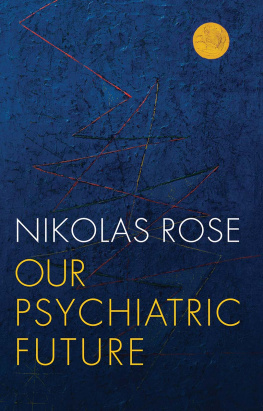Shrink Rap
SHRINK RAP
Three Psychiatrists Explain Their Work
Dinah Miller, M.D., Annette Hanson, M.D., and Steven Roy Daviss, M.D.

Notes to the Reader. This book is not meant to substitute for medical care of people with psychiatric illnesses, and treatment should not be based solely on its contents. Instead, treatment must be developed in a dialogue between the individual and his or her physician. Our book has been written to help with that dialogue.
Medications: The author and publisher have made reasonable efforts to determine that the selection and dosage of medications discussed in this text conform to the practices of the general medical community. The medications described do not necessarily have specific approval by the U.S. Food and Drug Administration for use in the diseases and dosages for which they are recommended. In view of ongoing research, changes in governmental regulations, and the constant flow of information relating to drug therapy and drug reactions, the reader is urged to check the package insert of each drug for any change in indications and dosage and for warnings and precautions. This is particularly important when the recommended agent is a new and/or infrequently used drug.
2011 Dinah Miller, Annette Hanson, Steven Roy Daviss
All rights reserved. Published 2011
Printed in the United States of America on acid-free paper
9 8 7 6 5 4 3 2 1
The Johns Hopkins University Press
2715 North Charles Street
Baltimore, Maryland 21218-4363
www.press.jhu.edu
LIBRARY OF CONGRESS CATALOGING-IN-PUBLICATION DATA
Miller, Dinah.
Shrink rap : three psychiatrists explain their work / Dinah Miller, Annette Hanson, and Steven Roy Daviss.
p. cm.
Includes index.
ISBN-13: 978-1-4214-0011-2 (hardcover : alk. paper)
ISBN-10: 1-4214-0011-1 (hardcover : alk. paper)
ISBN-13: 978-1-4214-0012-9 (pbk. : alk. paper)
ISBN-10: 1-4214-0012-x (pbk.: alk. paper)
1. Psychotherapy. 2. Psychotherapists.
3. PsychotherapyPractice. I. Hanson, Annette. II. Daviss, Steven Roy. III. Title.
RC480.5.M533 2011
616.8914dc22 2010039015
A catalog record for this book is available from the British Library.
Special discounts are available for bulk purchases of this book. For more information, please contact Special Sales at 410-516-6936 or specialsales@press.jhu.edu.
The Johns Hopkins University Press uses environmentally friendly book materials, including recycled text paper that is composed of at least 30 percent post-consumer waste, whenever possible. All of our book papers are acid-free, and our jackets and covers are printed on paper with recycled content.
Contents
Chapter 1.
Melissa and Oscar: Getting Help
What are the different types of mental health professionals?
What is a psychiatrist?
What is a forensic psychiatrist?
When a patient should see a psychiatrist rather than a primary care doctor
What is split treatment?
When a patient should see a psychiatrist for psychotherapy
When is split treatment better than care with only a psychiatrist?
Chapter 2.
Josh: A Walk through the System
The psychiatric evaluation and the mental status exam
The importance of outside informants
What is a chemical imbalance?
How psychiatric diagnoses are determined
Involuntary commitment to a psychiatric unit
What are a patients rights during hospitalization?
Chapter 3.
The Brandt Family: Why People Seek Care
For psychiatric disorders
When life gets hard and stress causes symptoms
For psychiatric symptoms caused by medical illnesses
For maladaptive personality styles
For addictive or compulsive behaviors
For suicidal thoughts or behaviors
For insight and education
Chapter 4.
Tara: Lets Talk
What is psychotherapy?
What are some different types of psychotherapy?
How psychiatrists learn to become psychotherapists
How are research studies conducted on psychotherapy as a treatment?
What people talk about in psychotherapy
What the psychiatrist does in psychotherapy
Privacy and confidentiality in the therapeutic relationship: on keeping secrets and minding HIPAA
Special exceptions: child custody subpoenas and the Patriot Act
Self-disclosure by the therapist
How long should treatment last?
Chapter 5.
Josh Revisited: Ask Your Doctor to Prescribe
How psychiatric medications are (sort of) classified
How a doctor chooses a medication Informed consent
Complementary and alternative treatments
How doctors dose medications
What happens when conventional treatments dont work?
Why psychiatrists dont like Xanax
Addictive medications in the treatment of the psychiatric patient
Chapter 6.
Becca: When Things Go Wrong
Difficulties with communication and poor patient-doctor fit
Recovered memory therapy
Disorders induced by the psychiatrist
When psychotherapy is inappropriately used as the only treatment
Side effects and adverse reactions from medications
Black box warnings
Antidepressants and suicide in young people and how the FDA decides on black box warnings
Boundary violations
Therapists who exploit patients
Chapter 7.
Eddie: A Child at Risk
Health care proxies, advance directives, and medical decision making for the dying patient
Informed consent and medical decisions for minors
Juvenile delinquency and the legal system
Custody evaluations: who gets the child?
Chapter 8.
Eddie: The Prison Patient
Specialty mental health courts and compelled treatment
Interrogation and why criminals confess
Psychopaths versus sociopaths and whether they can be treated
The insanity defense
What becomes of the insanity acquittee?
Psychiatric care in jail and in prison
Civil commitment of sex offenders
Chapter 9.
Mitchell: Hospital-based Psychiatry
What happens in the Emergency Department?
Finding a hospital bed for a psychiatric patient: insurance approval and bed availability
What happens during a psychiatric hospitalization?
Patient education, family involvement, and therapy
The agitated patient: restraint, seclusion, and forced medications
Shock treatments, or electroconvulsive therapy (ECT)
Bargaining for beds: insurance (again) and how psychiatric beds get allocated
Electronic health records
Day hospitals, or partial hospitalization programs
The consultation-liaison psychiatrist
Chapter 10.
Sharon: The Business of Psychiatry
Psychiatrists and insurance networks: how it all works
The missed appointment: no-shows and late cancellations
Preventing lawsuits
Providing safe environments for violent patients
When the patient assaults the psychiatrist
Changes in the patients ability to pay for care
Influences of the pharmaceutical industry
Happy birthday! Gifts from patients
Chapter 11.
Things We Argue About
Health care reform and how we allocate our treatments
What constitutes a psychiatric disorder: diagnostic criteria in the DSM age
Psychiatric disabilities and deciding who deserves special accommodation
Psychiatric disabilities in the workplace, from pilots to presidents
Medications with addictive potential
Medical marijuana for psychiatric disorders
Complementary and alternative treatments
The recovery model
Chapter 12.
The Future of Psychiatry
Next page






